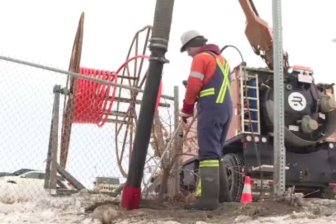TORONTO — A Toronto hospital has opened a stand-alone clinic where paramedics can drop off homeless people who are intoxicated by alcohol so they can recover and then access services.
Early results show dramatic improvements in ambulance offload times and freed-up beds at the hospital’s emergency department.
Three weeks ago, the University Health Network launched a “stabilization and connection centre” near its Toronto Western Hospital with several partners, including Toronto Paramedic Services.
Inside the 24-hour operation, there are 11 beds staffed by harm reduction workers, peer support workers, case workers and a physician on call.
Read more:
Paramedics warn overwhelmed Ontario hospitals causing spillover effects, fewer ambulances
Read More
“This is how we can deliver preferential care and options for people who are shut out of the system, have alcohol intoxication and do not require urgent or acute medical care,” said Dr. Andrew Boozary, the executive director of social medicine at the network and clinical lead on the project.
“The reality now is we can’t disconnect the shelter and housing crisis from the hospital bed crisis, so this is one way to address the problems with the system.”
The centre had a quiet launch, seeing 22 patients in its first two weeks. That is by design, with strict eligibility criteria in place: alcohol intoxication, no sign of drug use, normal vital signs and blood sugar levels, no recent trauma and no complicating medical factors.
It took only five weeks to open the clinic, Boozary said.
The hospital worked with the Ministry of Health and Ontario Health — which oversees the health system — to figure out how they could get ambulances on board. Legislation dictates ambulances only go to emergency departments, but the province has loosened those rules this year in an effort to divert certain patients to better spots.
The hospital was able to designate the new site as an extension of its emergency department, Boozary said.
Organizations involved in the effort include the hospital, the city, paramedics, The Neighbourhood Group charitable organization and Parkdale Queen West Community Health Centre.
Toronto paramedics say the early results of the program have been “almost unbelievable.”
“What’s really heartening is that because of this site, our paramedics are able to go there and basically offload patients in real-time, literally,” said Leo Tsang, deputy chief of operations for Toronto Paramedic Services.
“We can transfer care in eight-to-10 minutes so our ambulances can get back out to the street to service community calls. It’s been phenomenal.”
Ambulance offload delays have long been a problem but it has worsened in recent months as parts of Ontario have seen numerous “code zeros,” where no ambulance is available for a call. The problem has hit both large cities and rural areas.
Tsang said the citywide average ambulance drop-off time is about two hours. But that spikes depending on the hospital and day and time of the week. Paramedics can be with patients inside hospitals for upwards of eight hours until a bed frees up and the patient’s care can be transferred to the hospital, he said.
“Paramedics are a limited specialty resource and we need our medics out in the field,” Tsang said.
When paramedics drop a homeless patient off at the new clinic, the person is brought to a bed by a harm reduction worker who completes their intake.
“We meet them where they’re at and are non-judgmental,” said Mario Telles, an overdose prevention personal support worker with The Neighbhourhood Group who has been assigned to the new clinic for a month.

They check for injuries and drug use — signs of opioid use, especially fentanyl, are top of mind for Telles. If he discovers those issues, then they either contact the doctor on call — Boozary is one of the physicians _ or call for help.
There’s a “red phone” with a direct connection to the paramedics’ dispatch team, Tsang said.
“Otherwise, we just keep an eye on them and let them rest,” Telles said.
Once they begin to feel better, the patients can shower, shave and grab a bite to eat. The hospital also has a program to give out prepaid cellphones to patients so staff can stay in touch with them.
Nerissa MacLean is a case manager with The Neighbourhood Group who has worked with a mobile team for the past several years, going into shelters and out in the street.
She recently helped a patient get into supportive transitional housing for alcohol-use disorder. She’s helped others apply for identification and get into the full shelter system. The City of Toronto has reserved five beds across its system for those who come into the new stabilization centre.
MacLean can also help patients get set up on Ontario Works or the Ontario Disability Support Program. She’ll press housing workers to help look for permanent housing. She’ll also set patients up with another program that gives out clothes.
“Basically, my job is to help manage somebody’s life,” MacLean said.
The centre has plans to expand its strict eligibility criteria. The big one: opioid use, which is far more prevalent and deadly on the streets than alcohol.
“The overdose crisis is something that we just have to look at different solutions and this could be one way to help,” Boozary said.
For now, they’re getting the kinks out and sprucing up the place with Indigenous art to make it feel less institutional.
“I believe this integration of health and social care is the new way to better care for these patients,” Boozary said.
“And it helps free up space in our crowded emergency departments and gets paramedics back on the road where they belong, helping people.”
 Asian Tribune Your Multilingual Newspaper covering World and local news News
Asian Tribune Your Multilingual Newspaper covering World and local news News




